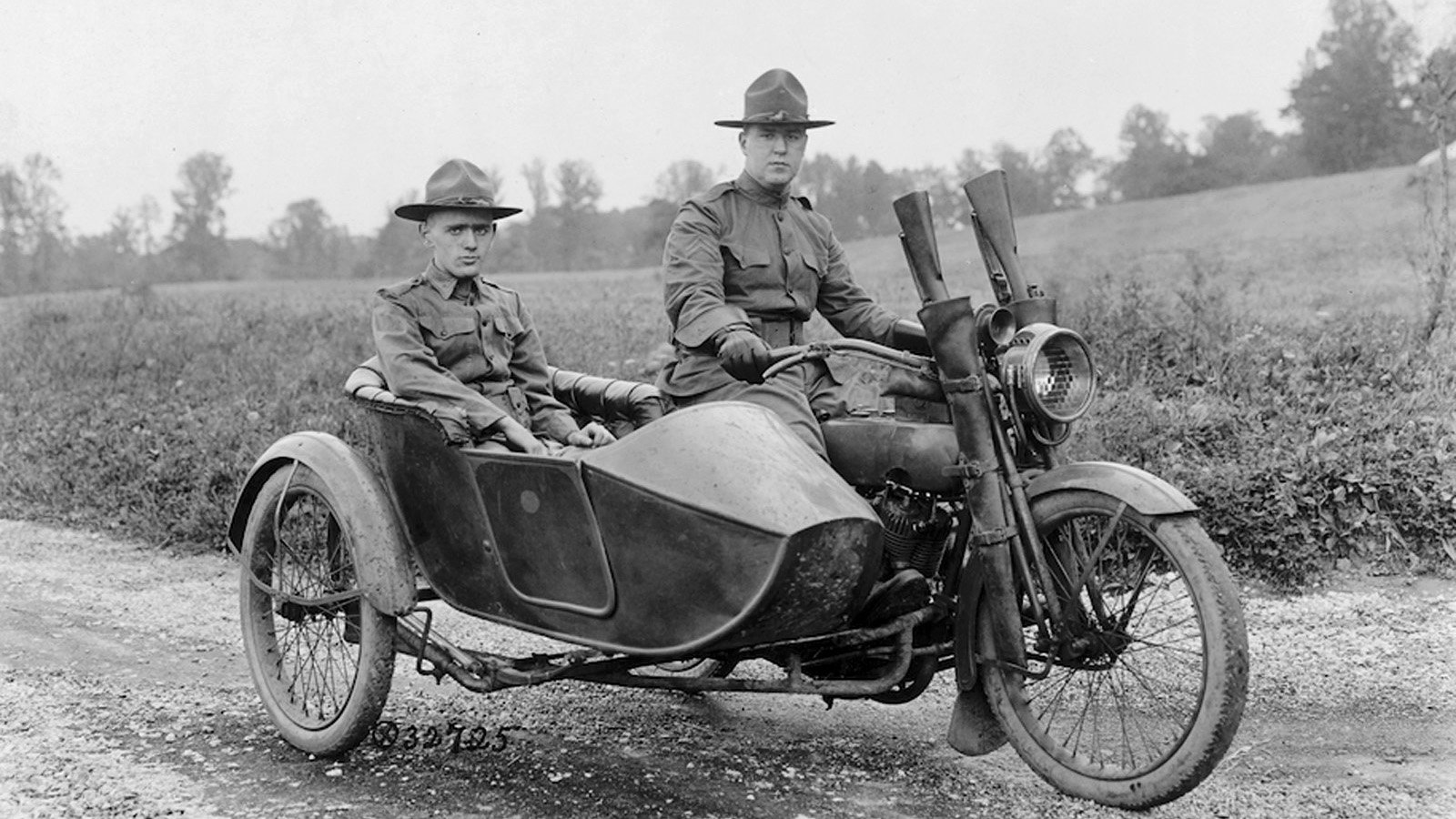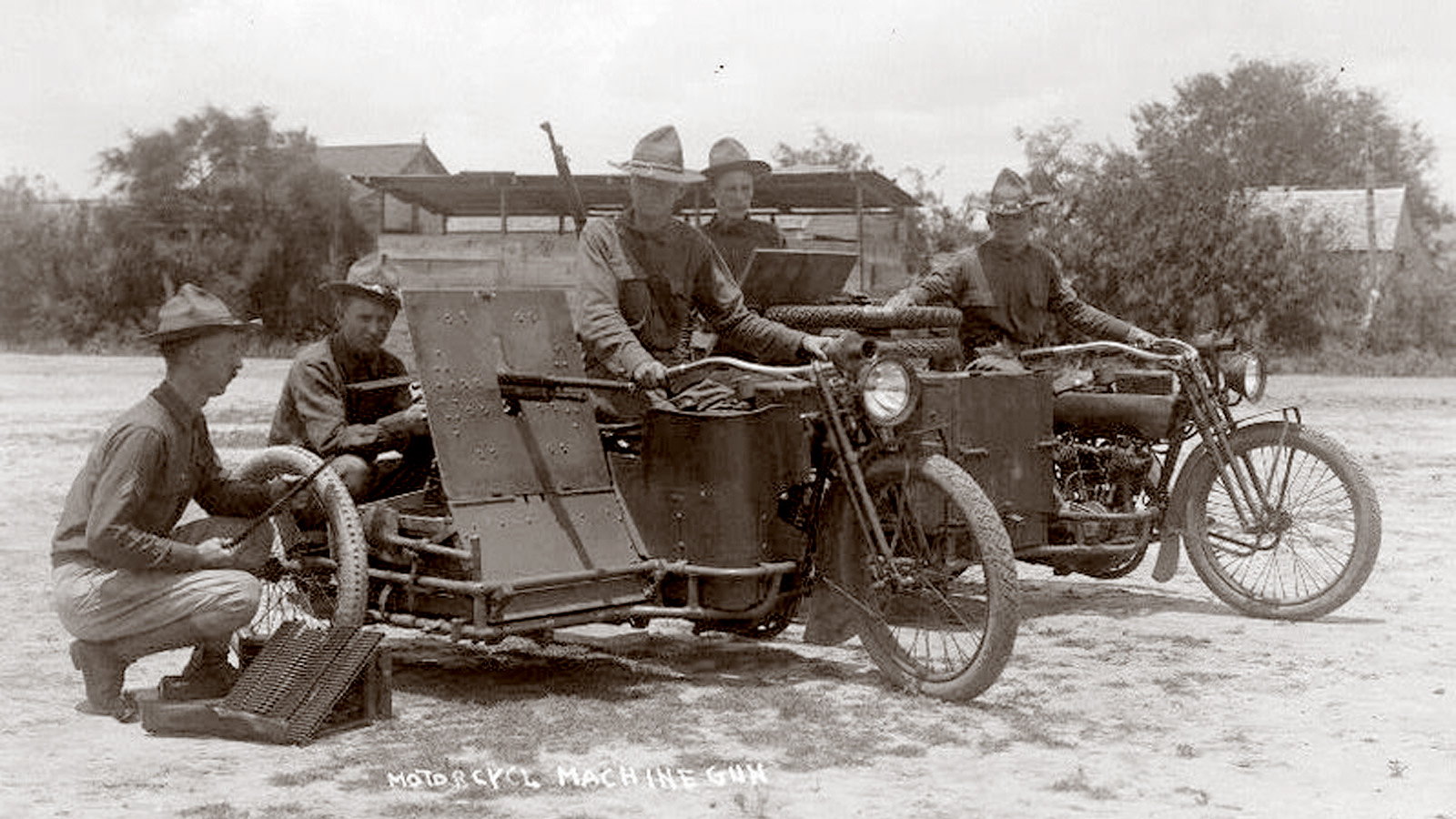National Archives: Harley-Davidson and the Military
Daily Slideshow: Previously unreleased National Archives photographs show Harley-Davidson motorcycle testing and training by the U.S. Army in preparation for WW1.


































Mobile Gun
When America entered World War 1 in April 1917, there was an urgent call to supply the U.S. Army with modern vehicles and equipment. Part of the Army's requirements were motorcycles, intended for use as dispatch riders, mobile gun platforms, and even ambulances.
Evaluation Orders
All three of the major American manufacturers, Harley-Davidson, Indian, and Excelsior, submitted motorcycles for Army evaluation. It is estimated that the U.S. Army used some 80,000 motorcycles during WW1. Harley-Davidson produced about one-third of all the war-time motorcycles in use from 1917 to 1918.
>>Join the conversation about motorcycles in WWI right here in the Harley-Davidson Forum!
Optioned Model
Among the models Harley-Davidson submitted for U.S. Army consideration was the 1918 Model 18-F, shown in this archive record, with the text: “Model 18-F three-speed twin, Prest-O-Lite attachment and side car.” The example in the image is a fully optioned machine with an acetylene generator for the headlight on the rear rack, a tire pump on the front fork, and a speedometer.
>>Join the conversation about motorcycles in WWI right here in the Harley-Davidson Forum!
Mexican Revolution
Harley-Davidson was no stranger to danger. Just prior World War 1, America was involved in the Mexican Revolution and although the effectiveness of that campaign was questionable, it did serve to entrench the value of motorcycles in combat as highly mobile and effective 'cavalry' units.
>>Join the conversation about motorcycles in WWI right here in the Harley-Davidson Forum!
Motorpool Shop Class
In a bid to secure future orders, Harley-Davidson offered incentives such as mechanical training courses for servicemen. Motorpool mechanics were taught how to service Harley-Davidson motorcycles in a workshop setting, and importantly, in the field.
>>Join the conversation about motorcycles in WWI right here in the Harley-Davidson Forum!
Motor School
In 1917, the U.S. Army in conjunction with Harley-Davidson created the School for Motor Mechanics. Harley-Davidson's approach of offering formal training was a savvy business move. The school created familiarity and brand loyalty among the thousands of trainee recruits, such as those shown here tearing-down motors with what appears to be a civilian instructor.
>>Join the conversation about motorcycles in WWI right here in the Harley-Davidson Forum!
Riding School
Along with mechanical instruction, Harley-Davidson provided riding courses to servicemen, most whom had likely never even sat on a motorcycle before. In this post-war archive record, the text reads: “Instruction on the operation of a motorcycle at the School for Motorcycle Mechanics.” The Harley-Davidson pictured is a modern unit with an electric light, a Klaxon horn, and sidecar.
>>Join the conversation about motorcycles in WWI right here in the Harley-Davidson Forum!
Quartermasters School
The School for Motorcycle Mechanics was, in fact, an extension of the already established Quartermasters School in Milwaukee, Wisconsin. The original Quartermasters School evolved through the decades and has now become the Harley-Davidson University, one of four HDMC institutions that teach mechanical, finance, and branding courses.
>>Join the conversation about motorcycles in WWI right here in the Harley-Davidson Forum!
Gray to Green
The 1917 model year brought with it the first ever color change in the early history of Harley-Davidson motorcycle production. Moving away from Renault Grey, Harley-Davidson adopted the U.S. Army specified olive green for both Army and civilian models. The green livery was continued until 1932, with civilian models sporting a polished paint-job and dark green pinstriping.
>>Join the conversation about motorcycles in WWI right here in the Harley-Davidson Forum!
Stretcher Bearer
Indian Motorcycles was Harley-Davidson's chief competitor for Army contracts. Shown here kitted-out as an ambulance in dull green livery, and not the familiar 'Indian' red, is the 1917 PowerPlus. The hugely popular PowerPlus V-twin appeared in 1916 with a 61 cubic-inch motor, hand-shift, three-speed transmission with a foot-operated clutch, and a chain-driven primary and rear. The PowerPlus earned the reputation of being reliable and almost unbreakable.
>>Join the conversation about motorcycles in WWI right here in the Harley-Davidson Forum!
Excelsior Series 18
Alongside rivals Harley-Davidson and Indian, Excelsior offered the Series 18 to the U.S. Army. With a 61 cubic-inch engine, the Series 18 featured the popular inlet-over-exhaust 'F-head' design which cooled the exhaust valve with the incoming fuel mixture. Excelsior also adopted the olive green paint scheme until 1920, when they returned to their patented blue livery.
>>Join the conversation about motorcycles in WWI right here in the Harley-Davidson Forum!
Supply Chain Woes
War-time motorcycle production was not without difficulty. Some parts that were sourced outside of the United States became unobtainable. Most notable were the German-made Bosch magnetos on the 1917 Model F and Model J series, that had to be replaced with domestic Splitdorf, or Dixie units.
>>Join the conversation about motorcycles in WWI right here in the Harley-Davidson Forum!
Model 18 Ambulance
Motorcycle ambulances were an innovation of WW1. The muddy conditions of the European battlefields meant that motorcycles with sidecars were essential in moving wounded soldiers off the front lines, and in rushing surgeons to aid-stations.
>>Join the conversation about motorcycles in WWI right here in the Harley-Davidson Forum!
Powerplus Ambulance
While some Harley-Davidson motorcycles were used in medical services, the predominant choice for the U.S. Army Ambulance Corps was the Indian Powerplus. The above image shows a stretcher-bearing training exercise at Van Cortlandt Park in New York.
>>Join the conversation about motorcycles in WWI right here in the Harley-Davidson Forum!
War Over
Corporal Roy Holtz is credited as the first American to enter Germany after WW1, on November 12, 1918. However, stories differ. Some sources state that Hotlz was captured just prior to the Armistice and then released, and is, in fact, leaving Germany in the above image. Regardless of which version is correct, Holtz executed his ingress, or egress, of Germany on a Harley-Davidson.
>>Join the conversation about motorcycles in WWI right here in the Harley-Davidson Forum!
Retired Surplus
About half of all the Harley-Davidson motorcycles produced during WW1 had gone to the U.S. Army. Post-war, tens-of-thousands of surplus American motorcycles, once used on the battlefields of Belgium and France, were collected for scrap or private sale. Pictured above is a 1919 wrecking-yard operated by the U.S. Army Corps of Engineers in Le Mans, France.
>>Join the conversation about motorcycles in WWI right here in the Harley-Davidson Forum!
HDMC Growth
Despite Indian Motorcycles having landed the largest Army contracts, the company emerged from WW1 destabilized and in financial difficulty. Most critical was lack of spare parts for the popular Powerplus, as the U.S. Army had consumed all of Indian's reserves. Harley-Davidson however, had only produced half as many motorcycles as Indian, and managed to continue growing as a company throughout the 1920s, and beyond.
>>Join the conversation about motorcycles in WWI right here in the Harley-Davidson Forum!
For help with service and maintenance of your Harley, check out the how to section of HDForums.com.

